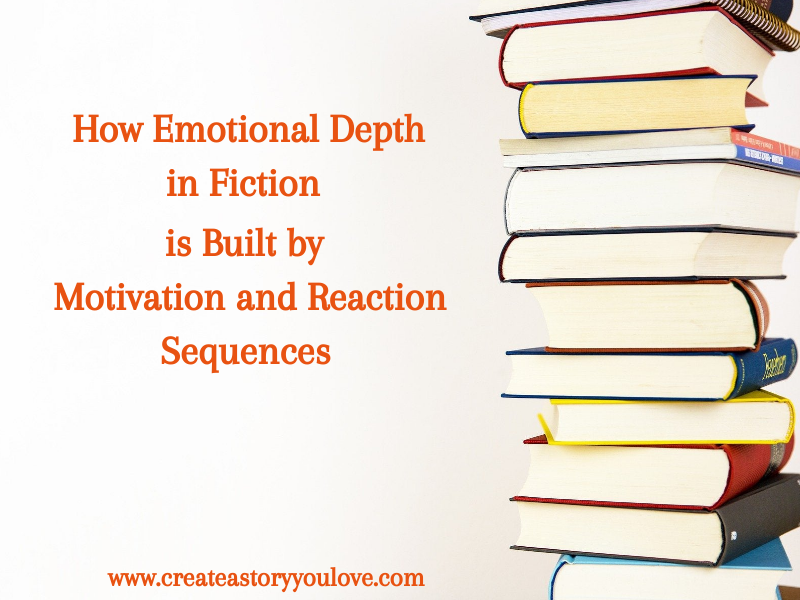Why do readers love to read fiction stories?
This question is answered in many different ways by fiction writers and readers everywhere. But one common answer I hear is this:
Readers long to experience the depth of emotions the main character(s) goes through in his/her journey which in turn helps the reader to relate to and find common ground from the Hero/Heroine’s journey that will help them find hope to overcome struggles in their own lives.
This has been my experience also, as an avid reader of fiction.
When I read a novel, I long to experience the depth of feeling that the Heroine is going through, so I can in some way relate, empathize, sympathize and feel excitement for the main character as they face obstacles trying to reach their goals.
The depth of the main character’s emotions are created by the writer through building motivation and reaction sequences.
Read below to learn more…

Your Hero or Heroine is your reader’s compass as they read your novel…
Your readers must care – empathize, sympathize – about your main character. If they don’t care about your hero or heroine, your readers will put down your book! And none of us storytellers wants to experience that…
How do you make readers care about what happens to your main character?
You must make your readers feel invested in what what happens. It’s in how you write your story, that places your readers in a position where they stand to win or lose… emotionally.
In order to do that, as fiction writers you must center your story on the main character who stands to win or lose — so that your readers feel like they are fighting for or against your Hero or Heroine.
Your Main Character’s most important roles as far as the Reader is concerned:
- Your Main Character is a constant throughout the novel that links the story line together and ties it together as a cohesive whole.
- Your Main Character also is where the reader’s attention is focused. So, your MC is also the person who gives meaning and significance to whatever happens in your novel.
- Whatever your Main Character does or says throughout your story creates feelings in the reader that are for or against — favorable or unfavorable — towards your MC.
All three of the above roles your Main Character plays are a natural process that readers of fiction go through as they read stories.
Essentially, as readers experience your novel, they judge your Main Character (relying on their own convictions and feelings about things), that in many cases lead your reader to feel/experience what your main character is going through.
Your reader lives through the story with your Main Character.
Since story is about change and conflict, your main character must have change in both their external and internal world.
These changes come about in your story world, through cause and effect. In other words, something happens in your story because something happened previously. Cause and Effect.
This is where Motivation and Reaction comes into play.
Simply put, motivation and reaction is a cause and effect pattern, applied to our main characters.
So, motivation is: anything outside of your Main Character to which she or he reacts.
And reaction is: anything your main character does as a result of how they were motivated.
Examples of motivation – reaction combinations:
1) The music ends; you sit down.
2) The clock tells you it’s time to leave; you get up.
When you put each of these motivation-reaction together, each combination shows a small change in circumstances or a change in the state o the character’s mind.
So each combination of motivation-reaction, moves your story a step forward. And one after another, as you write, your story gains momentum until you reach the finish line.
To build a motivation-reaction combination, you create it in chronological order:
First: The Motivating Stimulus
Second: The Character’s Reaction
- How the character is feeling.
- The character’s actions.
- The character’s speech.
Everything is done through your Main Character. This is on whom the spotlight shines in your novel. This is who the reader’s look at, to give meaning to all the events in your story.
This is especially important in regards to the emotions of your characters.
Most important to remember is that as you write, motivation always comes before reaction.
Example: The loud shot rang out and David jumped back. (David didn’t jump back and then the loud shot rang out).
If you hear a loud siren, quite possibly your blood pressure rises — and this is without conscious mental thought.
This is all done by instinctual feeling.
Feelings are beyond the control of the character experiencing those feelings… they just feel things.
The right reaction is the direct result of the right stimulus.
Similarly, if you choose the right motivation, you will control the direction of your story.
If you want a certain reaction from your character(s), choose a stimulus that will awaken that reaction.
So you can see that, a story is a continual string of motivation-reaction combinations. As these M-R combinations link together, they form the pattern of emotions for the characters in your story.
You might be asking: how can fiction writers get better at creating motivation-reaction combinations in their stories?
Answer: By,continuing to write stories. With each novel you complete, reread through each scene and see that: each character’s reaction is motivated and that each motivating stimulus awakens a reaction in your character.
Most of all, enjoy writing your story! 🙂
